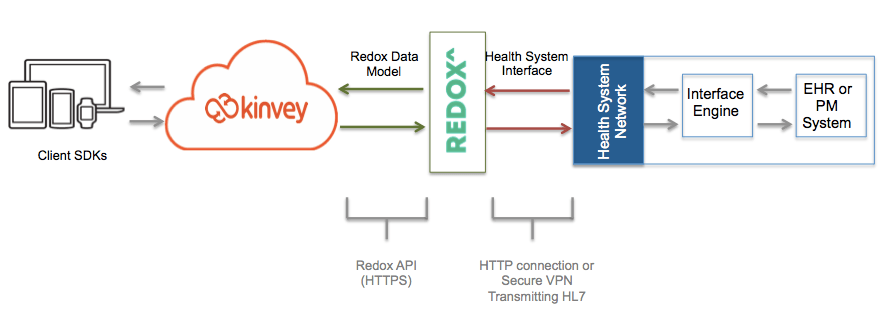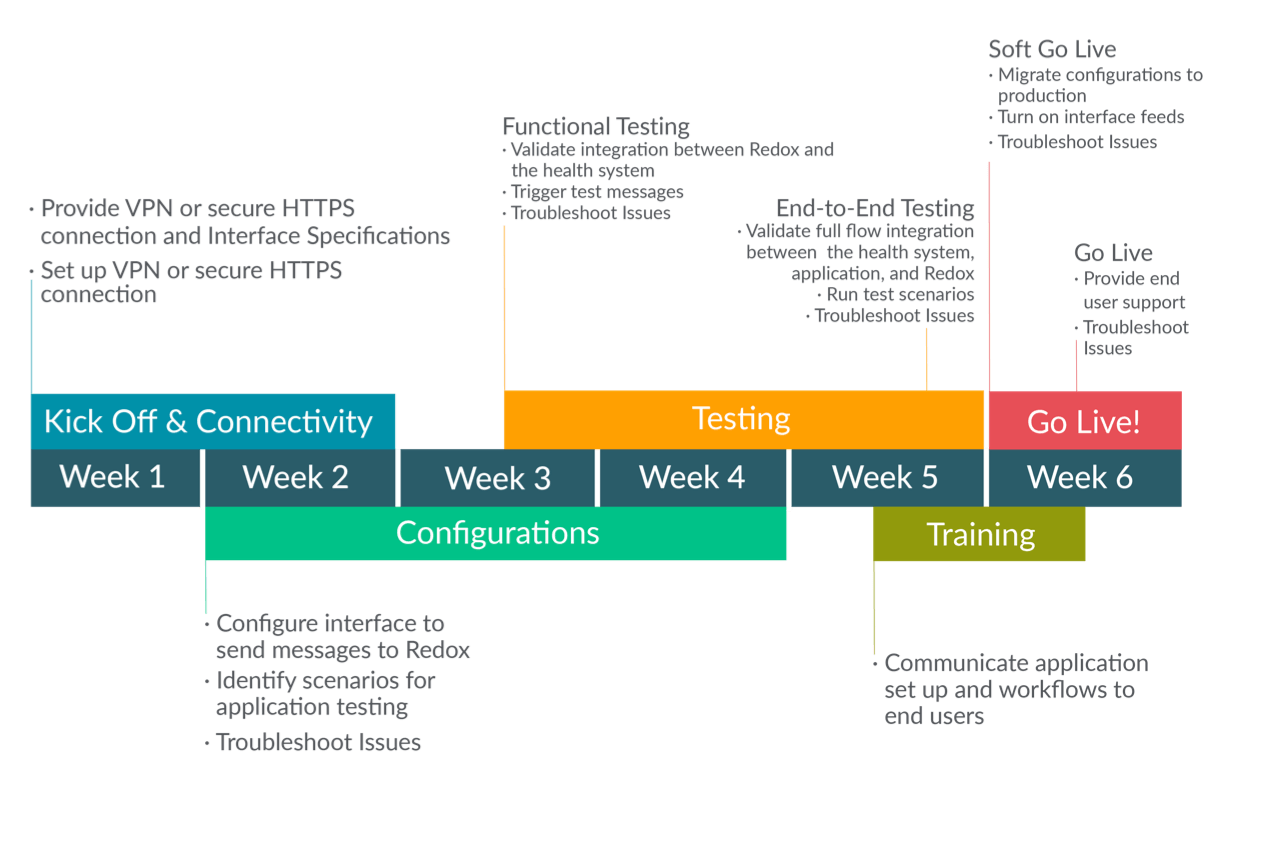Mobilize EHR Data & Build 5-Star HIPAA Compliant Apps Despite Clunky Interfaces

 Progress Kinvey and Redox partner to help healthcare innovators mobilize EHR data and accelerate delivery of mobile, web, and smart device apps. We recently did a joint webinar titled: Build 5 Star HIPAA Compliant Apps Despite Clunky EHRs. The webinar included a live demo of building an app with Kinvey that integrates an EHR via Redox. This is an especially great webinar to watch if you are a developer at at health system, digital agency servicing health systems or at a digital health startup. It shows you step by step what it takes to build a patient- and provider-facing app experience. Check it out here.
Progress Kinvey and Redox partner to help healthcare innovators mobilize EHR data and accelerate delivery of mobile, web, and smart device apps. We recently did a joint webinar titled: Build 5 Star HIPAA Compliant Apps Despite Clunky EHRs. The webinar included a live demo of building an app with Kinvey that integrates an EHR via Redox. This is an especially great webinar to watch if you are a developer at at health system, digital agency servicing health systems or at a digital health startup. It shows you step by step what it takes to build a patient- and provider-facing app experience. Check it out here.
If you don’t have time to watch the webinar, below is an overview of how an application development team can use Redox to mobilize health system EHR data for their app. Thanks to Redox for providing this content from your Road to Going Live whitepaper.
The Redox Approach to Mobilize EHR Data
Traditional Projects
First, it’s helpful to discuss what traditional integration projects look like so you can better understand how what we’re doing is different. Typically, to mobilize EHR data takes around six months. During that time, both your engineering team and the health system’s IT team will work hundreds of hours building custom interfaces that will enable your application to exchange data with the health system’s on-premise EHR. In addition to the finesse required to coordinate and execute a months-long project, this process will require extensive testing, troubleshooting, and reconfiguring of your product until it meets the health system’s requirements. From there, more testing is needed to ensure messages are exchanged in a secure and consistent way before going live.
Once integrated, your application will require ongoing maintenance and monitoring to ensure it’s functioning properly and within legal regulations. Dedicated staff will be committed to continually updating your configuration whenever a system change, outage, or any other unforeseen circumstance disrupts your connection.
With all that in place, the point-to-point interface you’ve spent months building is still only useful for the specific health system it was created for; the code cannot be reused anywhere else as each health system has a unique EHR configuration. It’s back to starting from scratch when you move onto the next integration.
Having a Partner on Your Side Allows you to Mobilize EHR Data Faster
With Redox as your integration partner, you can build against our modern API once and then reuse that connection regardless of the EHR vendor. Not only is this model incredibly more efficient, but the way we install and create these connections is too. And, when using Redox with Kinvey you have a full-featured, HIPAA Compliant app development platform. You just login and start developing. No assembly required.
You’ll never need to install any enterprise software or build out custom interfaces, meaning not only does your scaling potential dramatically increase, but it becomes easier and more efficient to integrate as you grow.
Redox’s connections to health systems are established through a secure VPN or HTTPS connection, and we provide continuous, 24/7 monitoring to ensure the data being exchanged with your application is always secure. Anytime an update is needed, be it from a workflow update or the health system completely changing their EHR vendor, we’ve got you covered—our built-from-the-ground-up engine can add new configurations as needed.
Lightweight Integration for Health Systems
One of our primary advantages is that our model is refreshingly efficient for health systems to implement. Unlike with point-to-point connections, they don’t have to manipulate messages in the interface engine or update web service configurations, because we’ll deliver messages to them however they would like. This cuts weeks of work and testing. Additionally, Redox has proactive monitoring and alerts built into our engine, so you can rest easy knowing the connections are secure.
The Redox team has deep experience working with health systems and some of the world’s largest EHR vendors. We know what works because we’ve spent decades working at health systems, EHR vendors, and digital health startups. We’ve implemented solutions targeting all areas of the care continuum at health systems around the country. The people who will be helping you with your application are committed to creating a world where access to patient data isn’t complicated. Our mission is to give patients more authority in accessing and managing their health, and we believe apps play a fundamental role in enabling that vision.
Key Players Required to Mobilize EHR Data
To ensure that everyone is on the same page and are referring to the same people, it’s helpful to know who’s going to be working on your integration project from each party involved. Here are the titles and roles of some health system employees who will be brought in to help complete this project, as well as a few other key players involved.
- Health System Project Champion—provides context for why the application is being installed and is the escalation point for project issues
- Health System IT Lead—primary contact for IT department and project issues
- Health System Interface Analyst—configures the interface to send/receive messages and sends test messages
- Health System EHR Analyst—makes updates to the EHR if needed and assists with workflow testing
- Network Analyst—assists with VPN connectivity and troubleshooting
- Redox Project Manager—provides project management support for the project and is responsible for Redox-owned tasks
- Application Lead—provides application-level project management (e.g., development completion) and leads workflow discovery
Getting Started
Below is a high level end-to-end view of EHR application data delivery as enabled by Redox and Kinvey. Kinvey provides the HIPAA compliant app development platform* with everything you need to build and run your apps and Redox provides the Healthcare API for rapid EHR integration and ongoing maintenance.
*Note: Kinvey HIPAA compliant backend is also now available as Progress Health Cloud

End-to-end application view
At the very beginning of the integration project, we’ll ask a handful of technical questions to figure out the EHR integration project scope. The answers will help the Redox Project Manager establish an accurate timeline for the project and determine what tasks need to be completed in which order.
Here are some questions to consider to get the ball rolling, as well as a graph depicting how integrated data will flow:
- Does the health system IT team support your EHRs/PM Systems, or is it outsourced to your vendor?
- Are those systems capable of sending and/or receiving HL7, or do they have web services available for integration needs?
- Do you have a list of existing HL7/web services that are enabled that you wouldn’t mind sharing?
- If you do not have HL7 feeds or web services enabled today, do you know what the engagement process looks like with the vendor?
Project Timeline
Beginning with finalizing your workflow and ending with going live, the timeline of a typical implementation is outlined below. Remember, the first integration project will always require the most amount of effort because everything is brand new. As we move forward, the work we’re completing now will enable future updates and upgrades to be nearly turnkey.

Mobilize EHR Data Project Timeline
Mobilize EHR Data Project Phases
Counting the initial Phase 0, five phases comprise an integration project to mobilize EHR data. Understanding each stage and the tasks that need to be completed is critical for executing a successful project.
Phase 0—Pre-Work & Discovery
Application Development Requirements
- Finalize Health System needs and workflow
- Review integration strategy with key stakeholders from operations and IT
- Application tasks
- Complete development for connecting to Redox API
- Reference the Redox sample app for help developing your endpoint and establishing connectivity with Redox.
Phase 1—Configuration
Review Sample Messages + Update EHR Configurations
- Health System Interface or Web Services Analyst:
- Provides Redox sample HL7/web services messages
- Redox Technical Lead:
- Validates that messages contain expected data fields for application
- Health System EHR Analyst:
- Completes needed EHR configuration updates
Phase 2—Connectivity
Secure Connection Between Health System and Redox + Complete Connectivity Testing
- Health System Network Analyst:
- Sets up a secure VPN connection with the Redox team
- Sets up an HTTPS connection with the Redox Team (if only API-based integration)
- Health System Interface Analyst:
- Configures message types to be sent over Redox-specified tunnel
- Redox Technical Lead:
- Works with interface analyst to trigger, review, and troubleshooting messages
Phase 3—Testing & Training
Validate Infrastructure Set-Up + Complete Patient Scenario Testing + Identify and Complete Training
- Health System Interface and EHR Analyst:
- Participate in integrated testing based on health system testing guidelines
- Work with application implementation lead to identify and execute training for successful application adoption
- Application Implementation Lead:
- Participate in integrated testing
- Work with health system to identify and execute training for successful application adoption
- Redox Implementation Lead:
- Participate in integrated testing
Phase 4—Go-Live
Production Updates + Soft Go Live + Go Live
- Redox Technical Lead:
- Review real messages as they pass into Redox
- Identify any additional configuration needs to ensure complete data matching
- Retest after configuration changes are completed
- Provide real time go live support for Day One
- Application Implementation Lead:
- Validate production messages look appropriate
- Retest after any configuration changes are completed
- Provide real time go live support for Day One
- Health System Interface Analyst:
- Move interface engine configuration to production environment
- Complete configuration-needs identified during soft go live
- Provide real-time go-live support for Day One
- Health System EHR Analyst:
- Move EHR configuration changes to production environment
- Review key workflows to ensure migration was successful
- Complete configuration needs identified during soft go live
- Provide real-time go-live support for Day One
Beyond Going Live
In parallel to successfully using Redox to mobilize EHR data, your frontend client app team can work independently via Kinvey’s decoupled architecture to develop the client app and you can marry them together via Kinvey Flex Services. You are now ready to go live!
For more information on how Redox can mobilize EHR data and integrate with Kinvey Backend as a Service (BaaS) to create HIPAA compliant apps quickly, check out our joint webinar here. If you ever need assistance or have questions about the technical aspects of your integration, both Kinvey and Redox are here to help. Reach out to their team at hello@redoxengine.com or contact us with any questions and someone will follow up with you shortly.
Learn more about Progress Health Cloud and how to build a HIPAA Complaint Application

